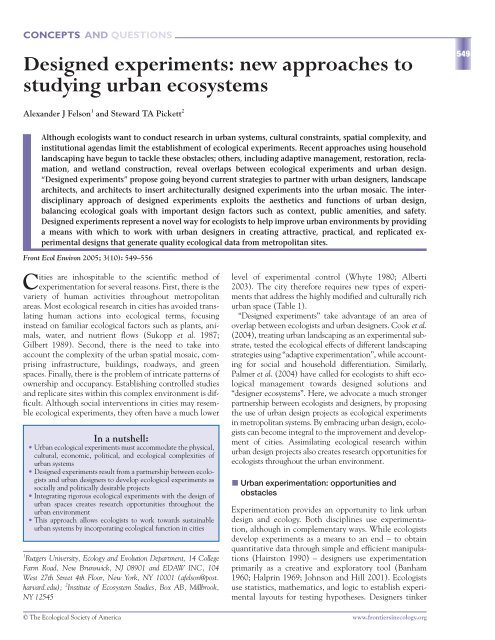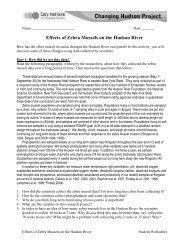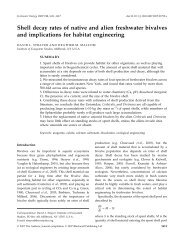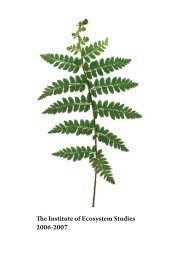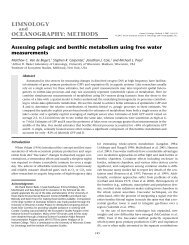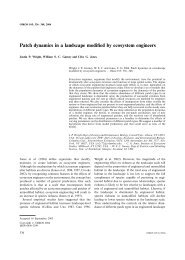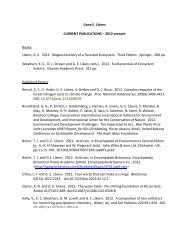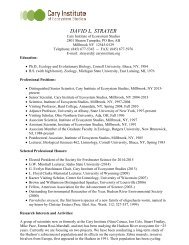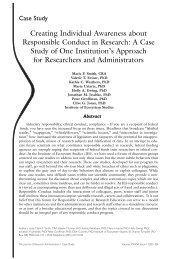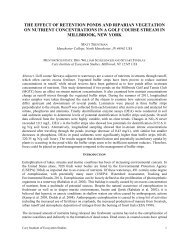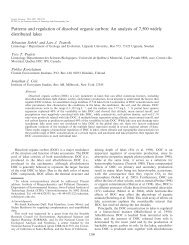Designed experiments: new approaches to studying urban ...
Designed experiments: new approaches to studying urban ...
Designed experiments: new approaches to studying urban ...
Create successful ePaper yourself
Turn your PDF publications into a flip-book with our unique Google optimized e-Paper software.
AJ Felson and STA Pickett<strong>Designed</strong> <strong>experiments</strong> in <strong>urban</strong> ecosystemsMatilsky 1992). Thus, in addition <strong>to</strong>showing the role art can play in generatingresearch with cultural meaning, hisefforts also represent an alternative route<strong>to</strong> funding <strong>urban</strong> ecological <strong>experiments</strong>.553East River marsh planterThe marsh planter project illustrates how<strong>experiments</strong> can combine education andaesthetics while acting as a functioningresearch <strong>to</strong>ol. In addition, it shows thatinstalling <strong>experiments</strong> in active <strong>urban</strong>zones creates opportunities for connectingthe public with ecological research. Theproposed project consists of a small-scale,experimental saltwater marsh planter <strong>to</strong>be constructed on Manhattan’s East River(Figure 4). The design, conceived by thefirm Ken Smith Landscape Architect, isintended <strong>to</strong> bring <strong>to</strong>gether aesthetics andfunction (Amidon 2005). With the EastRiver banks converted <strong>to</strong> vertical wallsand ocean-going boats creating severe wakes, the riparianedge is no longer hospitable <strong>to</strong> plant growth. Therefore,eight wooden planter boxes are <strong>to</strong> be placed on a pier,above mean high water, <strong>to</strong> avoid detrimental river conditions;saltwater grasses planted in the boxes will be grownin a sand and organic compost mix, with a bot<strong>to</strong>m layer ofwater-retaining polymers that substitute for the mud layer.The irrigation system will be flexible, including bothfreshwater sprinklers and an exposed saltwater system thatpumps water from the river in<strong>to</strong> the planters. Floodingwith the brackish East River water introduces nutrients,larvae, and minerals in<strong>to</strong> the constructed wetland.Scientists can develop small-scale controlled <strong>experiments</strong><strong>to</strong> study salinity gradients or <strong>to</strong> test res<strong>to</strong>ration techniquesand observe the creation of a mineral andnutrient plume below the planter, whichwill attract small bait fish and, in turn,lure larger preda<strong>to</strong>ry fish.Watershed 263Figure 3. Mel Chin’s Revival Field exemplifies an interdisciplinary approach <strong>to</strong><strong>urban</strong> research. Built between 1990 and 1993, it is located on Pig’s Eye Landfill inSt Paul, Minnesota.Long-term, large-scale, and planned mitigationsprovide an opportunity <strong>to</strong> buildand test multiple <strong>experiments</strong> within awatershed. Civic community engagementalso has a role <strong>to</strong> play in facilitating <strong>urban</strong><strong>experiments</strong>. The “greening” of a 367-has<strong>to</strong>rm drain watershed in Baltimore City,MD, is intended <strong>to</strong> reduce s<strong>to</strong>rmwaterflow and improve its quality (Figure 5).Plans involve increasing canopy coverand reducing the impervious cover onpublic lands. Numerous vacant lots, milesof piped streams, and under-used buildingsand infrastructure provide potential locations fordesigned <strong>experiments</strong>. Alterations in biodiversity, heavymetal pollution, microclimate, and a host of other fac<strong>to</strong>rscan be measured, along with the master variables of waterflow and quality, as greening in different sub-catchmentsproceeds. Through a partnership between ecologists anddesigners at Columbia University’s Graduate School ofArchitecture, Planning and Preservation, students areexploring experimental <strong>approaches</strong> for neighborhoodswithin the watershed (McGrath et al. in press).Partnerships between the city managers, not-for-profi<strong>to</strong>rganizations, and community groups are also proving <strong>to</strong>be important for the planning and maintenance of ecological<strong>experiments</strong>.Courtesy of M ChinFigure 4. The saltwater marsh planter by Ken Smith Landscape Architect,scheduled for construction in 2007, is an aesthetic research <strong>to</strong>ol adjacent <strong>to</strong> the 34thStreet Ferry Terminal on the East River in Manhattan. Drawing by author.© The Ecological Society of America www.frontiersinecology.org
<strong>Designed</strong> <strong>experiments</strong> in <strong>urban</strong> ecosystemsAJ Felson and STA Pickett554Courtesy of J Tran and M BrossaFigure 5. This diagram, developed in BP McGrath's <strong>urban</strong> design studio at ColumbiaUniversity, explores the design opportunities within Watershed 263 in Baltimore,Maryland.Green StreetsNew York City Parks Department’s (NYCP) Green StreetsProgram acquires remnant land in dense <strong>urban</strong> areas for<strong>urban</strong> greening. This project represents a modular, replicable,and adaptable approach <strong>to</strong> <strong>urban</strong> design installations,and also involves the application of temporary <strong>urban</strong>installations. Green Streets, which capitalizes on remnantspaces including medians, triangles, and unused sidewalks,is the result of an agreement between the NYCP and NewYork City Department of Transportation (NYCDOT) <strong>to</strong>install Parks planters on NYCDOT property, with theunderstanding that plants can be removed for roadwork(Figure 6). The reliance on the city’slarge capital budget instead of theNYCP’s limited annual expenses, andthe permission granted <strong>to</strong> GreenStreets <strong>to</strong> contract out for each project,allows the program <strong>to</strong> mobilize quicklyin an otherwise slow-moving bureaucracy.To date, over 2000 sites havebeen converted <strong>to</strong> planters. While theprogram currently has loosely environmentalaims, partnerships betweenecologists and <strong>urban</strong> designers couldtransform Green Streets in<strong>to</strong> multiplesmall-scale ecological <strong>experiments</strong> (BGunther pers comm).The projects discussed abovedemonstrate a variety of ways in whichecological data collection can beplanned, installed, funded, and supportedby communities and governmentagencies. While only a few areactually producing ecological data,<strong>to</strong>gether they illustrate ways of integrating<strong>experiments</strong> in<strong>to</strong> developmen<strong>to</strong>r revitalization projects that governments, developers,and communities will value and support. Anticipated outcomesWhat will designed <strong>experiments</strong> contribute <strong>to</strong> cities? Weenvision five possible outcomes.Meld analysis and aestheticsThe blending of quantitative analysis with aesthetics andfunction will generate opportunities for research whileNorthBronxManhattanQueensFigure 6. New York City Parks Department’s Green StreetsProgram, initiated in 1986 and reintroduced in 1996, hasinstalled over 2000 planters throughout the five New Yorkboroughs.StatenIslandBrooklynLegendGreenstreetOpen spacePark1 0 1MilesCourtesy of D Arroyowww.frontiersinecology.org© The Ecological Society of America
AJ Felson and STA Pickett<strong>Designed</strong> <strong>experiments</strong> in <strong>urban</strong> ecosystemscreating aesthetically pleasing amenities and enhancing<strong>urban</strong> space. For designers, the approach could provide a<strong>new</strong> design paradigm that builds on past movements,including modernism or the picturesque. Infusing educationaland aesthetic qualities in<strong>to</strong> <strong>urban</strong> experimentationwill raise its public value and help bring identity <strong>to</strong> otherwiseoften inconspicuous research sites.Play a useful role in the citySuch <strong>experiments</strong> would create design solutions thatadapt <strong>to</strong> site context and constraints, and address themultifaceted conditions of cities. They would function aspart of the city fabric, for example by improving safety,facilitating circulation, and creating park spaces. In thisway they would play a social or functional role, thusbecoming a conspicuous and lasting part of the city.Allow research in multiple locationsChanneling <strong>experiments</strong> through <strong>urban</strong> design projects willhelp spread research sites throughout the city. Exploitingthe range of conditions available in the metropolis isalready one of the goals that ecologists recognize throughsuch <strong>approaches</strong> as <strong>urban</strong>–rural gradients (McDonnell andPickett 1993; Table 1). <strong>Designed</strong> <strong>experiments</strong> take this furtherby making all designed buildings, infrastructure andlandscapes accessible as potential sites for experimentation.Provide a public identity for <strong>urban</strong> ecologyInserting simple experimental units in<strong>to</strong> multiple researchsites would help produce a set of common experimentaldesigns that become recognizable figures in everyday landscapes.These informational, functional, and aestheticadditions <strong>to</strong> the city should foster public appreciation andunderstanding. This, in turn, could help <strong>to</strong> reduce vandalism,encourage public participation in sustaining andmaintaining the <strong>experiments</strong>, and increase demand forsimilar <strong>experiments</strong> elsewhere. Public involvement mayalso be essential for tackling obstacles such as highly fragmentedprivate land ownership or regula<strong>to</strong>ry controls.Reintegrate ecological processes in<strong>to</strong> cities<strong>Designed</strong> <strong>experiments</strong> could reintroduce biological activity,such as enhanced vegetative structure, increased soilmicrobial activity, or improved riparian function, <strong>to</strong> <strong>urban</strong>areas. This infusion of ecological functions in<strong>to</strong> <strong>urban</strong>design practices, could ultimately result in a “retrofitting”of <strong>urban</strong> environments <strong>to</strong> include more biologically diversesystems and <strong>to</strong> better accommodate ecological functions. Conclusions<strong>Designed</strong> <strong>experiments</strong> are a potential means for ecologists<strong>to</strong> investigate <strong>urban</strong> ecology collaboratively with architects,landscape architects, and <strong>urban</strong> designers. Thisinterdisciplinary effort raises the potential for ecologists<strong>to</strong> become involved in the actual design process of <strong>urban</strong>areas. This allows the infusion of experimental goals andmoni<strong>to</strong>ring <strong>approaches</strong> in<strong>to</strong> the projects. Such <strong>experiments</strong>would take advantage of designed <strong>urban</strong> components,including buildings, streetscapes, parks, and infrastructure,<strong>to</strong> establish further research sites. Functioningboth for research and <strong>urban</strong> design, <strong>experiments</strong> willblend quantitative analysis with aesthetics and function,providing a cultural identity for experimental research,creating usable spaces for people, and contributing <strong>to</strong><strong>urban</strong> evolution. Through the effort of creating and then<strong>studying</strong> these spaces, ecologists will accumulate quantitativedata, which can then be fed back in<strong>to</strong> <strong>new</strong> experimentaldesign proposals. Over time, designed <strong>experiments</strong>have the potential <strong>to</strong> deepen our understanding ofhuman impacts on biological processes and <strong>to</strong> improvethe ecological function of human-dominated landscapes.<strong>Designed</strong> <strong>experiments</strong> expand traditional ecologicalgoals <strong>to</strong> include the <strong>new</strong> role of <strong>urban</strong> place-making.Merging ecology with design will help engage ecologists inattempts <strong>to</strong> structure and maintain <strong>urban</strong> environments.Focusing on the creation of <strong>urban</strong> ecological forms thatintegrate traditional research with the functional and aestheticdesign of <strong>urban</strong> space, ecologists will contribute <strong>to</strong><strong>urban</strong> processes and growth. As in adaptive managementused in forests and fisheries (Likens et al. 1995; Holling etal. 1996), <strong>urban</strong> ecologists could use designed <strong>experiments</strong>as a management <strong>to</strong>ol <strong>to</strong> predict, moni<strong>to</strong>r, and regulate<strong>urban</strong> ecological patterns and processes. Through a crossdisciplinaryexchange, these experimental strategieswould help place research within cultural, aesthetic, informational,and functional <strong>urban</strong> networks. AcknowledgementsThis paper is a contribution <strong>to</strong> the Baltimore EcosystemStudy, LTER (NSF DEB 9714835), and <strong>to</strong> the program ofthe Institute of Ecosystem Studies, with partial supportfrom the Mary Flagler Cary Charitable Trust. ReferencesAlberti M, Marzluff JM, Shulenberger E, et al. 2003. Integratinghumans in<strong>to</strong> ecology: opportunities and challenges for <strong>studying</strong><strong>urban</strong> ecosystems. Bioscience 53: 1169–79.Amidon J. 2005. Ken Smith Landscape Architect: <strong>urban</strong> projects.Prince<strong>to</strong>n, NJ: Prince<strong>to</strong>n Architectural Press.Bacon EN. 1967. Design of cities. New York, NY: Viking Press.Banham R. 1960. Theory and design in the first machine age.Cambridge, MA: MIT Press.Beardsley J. 1984. Earthworks and beyond: contemporary art in thelandscape. New York, NY: Abbeville Press.Berkowitz A, Nilon CH, and Hollweg KS (Eds). 2003.Understanding <strong>urban</strong> ecosystems: a <strong>new</strong> frontier for scienceand education. New York, NY: Springer-Verlag.Bradshaw AD and Chadwick MJ. 1980. The res<strong>to</strong>ration of land:the ecology and reclamation of derelict and degraded land.Berkeley, CA: University of California Press.Calthorpe P. 1995. The next American metropolis: ecology, com-555© The Ecological Society of America www.frontiersinecology.org
556<strong>Designed</strong> <strong>experiments</strong> in <strong>urban</strong> ecosystemsmunity, and the American dream. Prince<strong>to</strong>n, NJ: Prince<strong>to</strong>nArchitectural Press.Clay G. 1973. Close up: reading the American landscape. NewYork, NY: Praeger Publisher.Connecticut Department of Environmental Protection. 2002.Nonpoint Source Fact Sheet: Jordan Cove Urban Moni<strong>to</strong>ringProject Bureau of Water Management, Planning & StandardsDivision. www.dep.state.ct.us/wtr/nps/succs<strong>to</strong>r/jordncve.pdf.Viewed 2 November 2005.Cook WM, Casagrande DG, Hope D, et al. 2004. Learning <strong>to</strong> rollwith the punches: adaptive experimentation in human-dominatedsystems. Front Ecol Environ 2: 467–74.Corner J. 1999. Eidetic operations and <strong>new</strong> landscapes. In: Corner J(Ed). Recovering landscape: essays in contemporary landscapearchitecture. New York, NY: Prince<strong>to</strong>n Architectural Press.Cronon W. 1991. Nature’s metropolis: Chicago and the great West.New York, NY: WW Nor<strong>to</strong>n & Company.Dickinson J. 1999. Journey in<strong>to</strong> space: interpretations of landscapein contemporary art. In: Nye DE (Ed). Technologies of landscape:from reaping <strong>to</strong> recycling. Amherst, MA: University ofMassachusetts Press.Forman R. 1995. Land mosaics: the ecology of landscapes andregions. Cambridge, MA: Cambridge University Press.Giedion S. 1963. Space, time and architecture: the growth of a <strong>new</strong>tradition. Cambridge, MA: Harvard University Press.Gilbert OL. 1989. The ecology of <strong>urban</strong> habitats. New York, NY:Chapman Hall.Gordon D (Ed). 1990. Green cities, ecologically sound <strong>approaches</strong><strong>to</strong> <strong>urban</strong> space. Montreal, Canada: Black Rose Books.Goudie A. 1994. The human impact on the natural environment.Cambridge, MA: MIT Press.Grimm NB, Grove JM, Pickett STA, and Redman CL. 2000.Integrated <strong>approaches</strong> <strong>to</strong> long-term studies of <strong>urban</strong> ecologicalsystems. BioScience 50: 571–84.Grove JM and Burch WR. 1997. A social ecology approach andapplications of <strong>urban</strong> ecosystem and landscape analyses: a casestudy of Baltimore, Maryland. Urban Ecosyst 1: 259–75.Hairs<strong>to</strong>n NG. 1990. Ecological <strong>experiments</strong>: purpose, design, andexecution. Cambridge, MA: Cambridge University Press.Halprin L. 1969. The RSVP cycle: creative process in the humanenvironment. New York, NY: George Braziller, Inc.Hann SS, Folke C, and Maler CJ (Eds). Rights <strong>to</strong> nature.Washing<strong>to</strong>n, DC: Island Press.Holling CS. 1996. Dynamics of (dis)harmony in ecological andsocial systems. In: Hann SS, Folke C, and Maher CJ (Eds).Rights <strong>to</strong> nature. Washing<strong>to</strong>n, DC: Island Press.Jacobs J. 1961. The death and life of great American cities. NewYork, NY: Random House.Johnson BR and Hill K (Eds). 2001. Ecology and design: frameworksfor learning. Washing<strong>to</strong>n, DC: Island Press.Kirkwood N (Ed). 2001. Manufactured sites: rethinking the postindustriallandscape. New York, NY: Routledge.Kohler RE. 2002. Landscapes and labscapes: exploring the lab–fieldborder in biology. Chicago, IL: Chicago University Press.Likens GE, Bormann FH, Pierce RS, et al. 1995. Biogeochemistryof a forested ecosystem. New York, NY: Springer-Verlag.Lynch K and Hack G. 1984. Site planning. Cambridge, MA: MITPress.AJ Felson and STA PickettMatilsky BC. 1992. Fragile ecologies: contemporary artists’ interpretationsand solutions. New York, NY: Rizzoli.McHarg I. 1969. Design with nature. Garden City, NY: NaturalHis<strong>to</strong>ry Press.McGrath B, Cadenasso ML, Grove JM, et al. (Eds). 2005.Designing <strong>urban</strong> patch dynamics. Prince<strong>to</strong>n, NJ: Prince<strong>to</strong>nArchitectural Press.McDonnell MJ and Pickett STA (Eds). 1993. Humans as componentsof ecosystems: the ecology of subtle human effects andpopulated areas. New York, NY: Springer-Verlag.Ndubis F. 1997. Landscape ecological planning. In: ThompsonnGF and FR Steiner (Eds). Ecological design and planning.Hoboken, NJ: John Wiley & Sons, Inc.Meyer EK. 2000. The post-earth day conundrum: translating environmentalvalues in<strong>to</strong> landscape design. In: Conan M (Ed).Environmentalism in landscape architecture. Washing<strong>to</strong>n,DC: Dumbar<strong>to</strong>n Oaks.Palmer MA, Bernhardt E, Chornesky E, et al. 2004. Ecology for acrowded planet. Science 304: 1251–52.Pickett STA, Cadenasso ML, and Grove JM. 2004. Resilient cities:meaning, models, and metaphor for integrating the ecological,socio-economic, and planning realms. Landscape Urban Plan69: 369–84.Pickett STA, Cadenasso ML, Grove JM, et al. 2001. Urban ecologicalsystems: linking terrestrial, ecological, physical and socioeconomiccomponents of metropolitan areas. Annu Rev Ecol Syst32: 127–57.Porteous JD. 1996. Environmental aesthetics: ideas, politics andplanning. London, UK: Routledge.Robertson DP and RB Hull. 2001. Beyond biology: <strong>to</strong>ward a morepublic ecology for conservation. Conserv Biol 15: 970–79.Spaid S. 2002. Ecovention: current art <strong>to</strong> transform ecologies.Cincinnati, OH: The Contemporary Art Center, Ecoartspace.www.greenmuseum.org/c/ecovention/. Viewed 2 November 2005.Spirn AW. 1996. Constructing nature: The legacy of Fredrick LawOlmsted. In: Cronon W (Ed). Uncommon ground: rethinkingthe human place in nature. New York, NY: WW Nor<strong>to</strong>n &Company.Sukopp HS and Kowarik I (Eds). 1987. Urban ecology: plants andplant communities in <strong>urban</strong> environments. The Hague,Netherlands: SPB Academic Publishing.Thompson GF and Steiner FR (Eds). 1997. Ecological design andplanning. New York, NY: John Wiley & Sons, Inc.Thorne JF and Huang CS. 1991. Toward a landscape ecologicalaesthetic: methodologies for designers and planners. LandscapeUrban Plan 21: 61–79.Underwood AJ. 1997. Experiments in ecology: their logical designand interpretation using analysis of variance. Cambridge, MA:Cambridge University Press.Vi<strong>to</strong>usek FM, Mooney HA, Lubchenco J, and Melillo JM. 1997.Human domination of Earth’s ecosystems. Science 277: 494–99.Walters CJ and Hollings CS. 1990. Large-scale management <strong>experiments</strong>and learning by doing. Ecology 71: 2060–68.Whyte WH. 1980. The social life of small <strong>urban</strong> spaces.Washing<strong>to</strong>n, DC: The Conservation Foundation.Zipperer WC, Wu J, Pouyat RV, and Pickett STA. 2000. The applicationof ecological principles <strong>to</strong> <strong>urban</strong> and <strong>urban</strong>izing landscapes.Ecol Appl 10: 685–88.www.frontiersinecology.org© The Ecological Society of America


